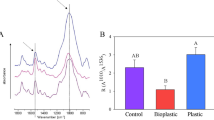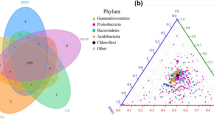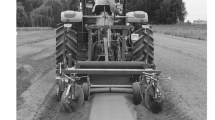Abstract
Plastics are used widely as agricultural mulches to suppress weeds and retain soil moisture. Disposal of conventional plastic mulches requires physical removal for disposal in a landfill or incineration. Biodegradable plastic mulches that could be tilled into the soil at the end of a growing season represent an attractive alternative to conventional plastic mulches. In this study, three commercially available mulches labeled as “biodegradable” and one experimental, potentially biodegradable mulch were used during a tomato growing season, and then buried in field soil at three locations for approximately 6 months, as would occur typically in an agricultural setting. Degradation after 6 months in soil was minimal for all but the cellulosic mulch. After removal of mulches from soil, fungi were isolated from the mulch surfaces and tested for their ability to colonize and degrade the same mulches in pure culture. The majority of culturable soil fungi that colonized biodegradable mulches were within the family Trichocomaceae (which includes beneficial, pathogenic, and mycotoxigenic species of Aspergillus and Penicillium). These isolates were phylogenetically similar to fungi previously reported to degrade both conventional and biodegradable plastics. Under pure culture conditions, only a subset of fungal isolates achieved detectable mulch degradation. No isolate substantially degraded any mulch. Additionally, DNA was extracted from bulk soil surrounding buried mulches and ribosomal DNA was used to assess the soil microbial community. Soil microbial community structure was significantly affected by geographical location, but not by mulch treatments.









Similar content being viewed by others
References
Albertsson A-C, Ranby B (1979) Biodegradation of synthetic polymers. IV. The 14CO2 method applied to a linear polyethylene containing a biodegradable additive. J Appl Polym Sci Appl Polym Symp 35:423
Alexopoulos CJ, Mims CW, Blackwell M (1996) Introductory mycology, 4th edn. John Wiley and Sons, Inc., New York, p 308
Altschul SF, Gish W, Miller W, Myers EW, Lipman DJ (1990) Basic local alignment search tool. J Mol Biol 215:403–410
Anderson MJ, Willis TJ (2003) Canonical analysis of principal coordinates: a useful method of constrained ordination for ecology. Ecology 84:511–525
ASTM D 5988-12 (2012) Standard test method for determining aerobic biodegradation of plastic materials in soil. American Society for Testing and Materials International, West Conshohocken
ASTM D 6400-04 (2004) (2004) Standard specification for compostable plastics. American Society for Testing and Materials International, West Conshohocken
Bailes G, Lind M, Ely A, Powell M, Moore-Kucera J, Miles C, Inglis D, Brodhagen M (2013) Isolation of native soil microorganisms with potential for breaking down biodegradable plastic films used in agriculture. J Vis Exp 75:e50373. doi:10.3791/50373
Benedict CV, Cook WJ, Jarrett P, Cameron JA, Huang SJ, Bell JP (1983a) Fungal degradation of polycaprolactones. J Appl Polym Sci 28:327–334
Benedict CV, Cameron JA, Huang SJ (1983b) Polycaprolactone degradation by mixed and pure cultures of bacteria and a yeast. J Appl Polym Sci 28:335–342
Bhardwaj H, Gupta R, Tiwari A (2013) Communities of microbial enzymes associated with biodegradation of plastics. J Polym Environ 21:575–579
Borneman J, Hartin RJ (2000) PCR primers that amplify fungal rRNA genes from environmental samples. Appl Environ Microbiol 66:4356–4360
Cai H, Dave V, Gross RA, McCarthy SP (1996) Effects of physical aging crystallinity, and orientation on the enzymatic degradation of poly(lactic acid). J Polym Sci B Polym Phys 34:2701–2708
Caporaso GJ, Kuczynski J, Stombaugh J, Bittinger K, Bushman FD, Costello EK, Fierer M, Gonzalez Peña A, Goodrich JK, Gordon JI, Huttley GA, Kelley ST, Knights D, Koenig JE, Ley RE, Lozupone CA, McDonald D, Muegge BD, Pirrung M, Reeder J, Sevinsky JR, Turnbaugh PJ, Walters WA, Widmann J, Yatsunenko T, Zaneveld J, Knight R (2010) Qiime allows analysis of high-throughput community sequencing data. Nat Methods 7:335–336
Cook WJ, Cameron JA, Bell JP, Huang SJ (1981) Scanning electron microscopic visualization of biodegradation of polycaprolactones by fungi. J Polym Sci B 19:159–165
CSN EN 13432 (2000) Packaging—requirements for packaging recoverable through composting and biodegradation—test scheme and evaluation criteria for the final acceptance of packaging. CSN EN Standards, British-Adopted European Standard, European Committee for Standardization, Brussels
Culleton H, McKie V, de Vries RP (2013) Physiological and molecular aspects of degradation of plant polysaccharides by fungi: what have we learned from Aspergillus? Biotechnol J 8:884–894
De Gannes V, Eudoxie G, Hickey WJ (2013) Insights into fungal communities in composts revealed by 454-pyrosequencing: implications for human health and safety. Front Microbiol 4:164. doi:10.3389/fmicb.2013.00164
Desjardins AE (2006) Fusarium mycotoxins: chemistry, genetics, and biology. APS Press, St. Paul
Drumright RE, Gruber PR, Henton DE (2000) Polylactic acid technology. Adv Mater 12:1841–1846
Edgar RC (2010) Search and clustering orders of magnitude faster than BLAST. Bioinformatics 26:2460–2461
Edgar RC, Haas BJ, Clemente JC, Quince C, Knight R (2011) UCHIME improves sensitivity and speed of chimera detection. Bioinformatics 27:2194–2200
El-Shafei H, El-Nasser NHA, Kansoh AL, Ali AM (1998) Biodegradation of disposable polyethylene by fungi and Streptomyces species. Polym Degrad Stab 62:361–365
Fontanille P, Kumar V, Christophe G, Nouaille R, Larroche C (2012) Bioconversion of volatile fatty acids into lipids by the oleaginous yeast Yarrowia lipolytica. Bioresour Technol 114:443–449
Fossi MC, Panti C, Guerranti C, Coppola D, Giannetti M, Marsili L, Minutoli R (2012) Are baleen whales exposed to the threat of microplastics? A case study of the Mediterranean fin whale (Balaenoptera physalus). Mar Pollut Bull 4:2374–2379
Fry DM, Fefer SI, Sileo L (1987) Ingestion of plastic by Laysan Albatrosses and Wedge-tailed Shearwaters in the Hawaiian Islands. Mar Pollut Bull 18:339–343
Ghosh SK, Pal S, Ray S (2013) Study of microbes having potentiality for biodegradation of plastics. Environ Sci Pollut Res 20:4339–4355
Gregory MR (2009) Environmental implications of plastic debris in marine settings—entanglement, ingestion, smothering, hangers-on, hitch-hiking and alien invasions. Phil Trans R Soc B 364:2013–2025. doi:10.1098/rstb.2008.0265
Hall TA (1999) BioEdit: a user-friendly biological sequence alignment editor and analysis program for Windows 95/98/NT. Nucl Acids Symp Ser 41:95–98
Hammer J, Kraak MHS, Parsons JR (2012) Plastics in the marine environment: the dark side of a modern gift. Rev Environ Contam T 220:1–44. doi:10.1007/978-1-4614-3414-6_1
Hayes DG, Dharmalingam S, Wadsworth LC, Leonas KK, Miles C, Inglis DA (2012) Biodegradable agricultural mulches derived from biopolymers. In: Khemaani K, Scholz C (eds) Degradable polymers and materials, principles and practice, 2nd edn. ACS Symposium Series, vol 1114, 2nd edn. American Chemical Society Press, Washington, DC, pp 201–223
Henton DE, Gruber P, Lunt J, Randall J (2005) Polylactic acid technology. In: Mohanty AK, Misra M, Drzal LT (eds) Natural fibers, biopolymers, and biocomposites. Taylor & Francis, Boca Raton, pp 527–577
Hill EE, Hankin L, Stephens GR (1982) Mulches: Their effects on fruit set, timing and yields of vegetables. Bulletin 805. The Connecticut Agricultural Experiment Station, New Haven
Hirsch P (1986) Microbial life at extremely low nutrient levels. Adv Space Res 6:287–298
Imam SH, Tosteson TR (1992) Fate of starch-containing plastic films exposed in aquatic habitats. Curr Microbiol 25:1–8
ISO 17556 (2012) Plastics—determination of the ultimate aerobic biodegradability of plastic materials in soil by measuring the oxygen demand in a respirometer or the amount of carbon dioxide evolved. International Organization for Standardization, Geneva
Isola D, Selbmann L, de Hoog GS, Fenice M, Onofri S, Prenafeta-Boldú FX, Zucconi L (2013) Isolation and screening of black fungi as degraders of volatile aromatic hydrocarbons. Mycologia 175:369–379
Kamiya M, Asakawa S, Kimura M (2007) Molecular analysis of fungal communities of biodegradable plastics in two Japanese soils. Soil Sci Plant Nutr 53:568–574
Karamanlioglu M, Robson GD (2013) The influence of biotic and abiotic factors on the rate of degradation of poly(lactic) acid (PLA) coupons buried in compost and soil. Polym Degrad Stab 98:2063–2071
Karjomaa S, Suortti T, Lempiäinen R, Selin J-F, Itävaara M (1998) Microbial degradation of poly-(L-lactic acid) oligomers. Polym Degrad Stab 59:333–336
Kasirajan S, Ngouajio M (2012) Polyethylene and biodegradable mulches for agricultural applications: a review. Agron Sustain Dev 32:501–529
Kawai F (2010) Polylactic acid (PLA)-degrading microorganisms and PLA depolymerases. In: Cheng H, Gross RA (eds) Green polymer chemistry: Biocatalysis and biomaterials, ACS Symposium Series. American Chemical Society, Washington, DC
Kern ME, Blevins KS (1997) Medical mycology: A self-instructional text, 2nd edn. FA Davis Company, Philadelphia
Kijchavengkul T, Auras R, Rubino M, Ngouajio M, Fernandez RT (2008) Assessment of aliphatic-aromatic copolyester biodegradable mulch films. Part I: Field study. Chemosphere 71:942–953
Krzan A, Hemjinda S, Miertus S, Corti A, Chiellini E (2006) Standardization and certification in the area of environmentally degradable plastics. Polym Degrad Stab 91:2819–2833
Kuhn DM, Ghannoum MA (2003) Indoor mold, toxigenic fungi, and Stachybotrys chartarum: infectious disease perspective. Clin Microbiol Rev 16:144–172
Laist DW (1997) Impacts of marine debris: Entanglement of marine life in debris including a comprehensive list of species with entanglement and ingestion records. In: Coe JM, Rogers DB (eds) Marine debris. Springer, Berlin
Larkin MA, Blackshields G, Brown NP, Chenna R, McGettigan PA, McWilliam H, Valentin F, Wallace IM, Wilm A, Lopez R, Thompson JD, Gibson TJ, Higgins DG (2007) Clustal W and Clustal X version 2.0. Bioinformatics 23:2947–2948
Li C, Moore-Kucera J, Miles C, Leonas K, Lee J, Corbin A, Inglis D (2014) Degradation of potentially biodegradable plastic mulch films at three diverse U.S. locations. Agroecol Sustain Food Sys (formerly J Sustain Agr) (in press)
Lunt J (2000) Polylactic acid polymers for fibers and nonwovens. International Fiber Journal 15:48–52
Maeda H, Yamagata Y, Abe K, Hasegawa F, Machida M, Ishioka R, Gomi K, Nakajima T (2005) Purification and characterization of a biodegradable plastic-degrading enzyme from Aspergillus oryzae. Appl Microbiol Biotechnol 67:778–788
McDonald D, Price MN, Goodrich J, Nawrocki EP, DeSantis TZ, Probst A, Andersen GL, Knight R, Hugenholtz P (2012) An improved Greengenes taxonomy with explicit ranks for ecological and evolutionary analyses of bacteria and archaea. ISME J 6:610–618
Mellon JE, Cotty PJ, Dowd MK (2007) Aspergillus flavus hydrolases: their roles in pathogenesis and substrate utilization. Appl Microbiol Biotechnol 77:497–504
Miles C, Wallace R, Wszelaki A, Martin J, Cowan J, Walters T, Inglis D (2012) Deterioration of potentially biodegradable alternatives to black plastic mulch in three tomato production regions. HortSci 47:1–8
Mogil’nitskii GM, Sagatelyan RT, Kutishcheva TN, Zhukova SV, Kerimov SI, Parfenova TB (1987) Disruption of the protective properties of the polyvinyl chloride coating under the effect of microorganisms. Prot Met 23(Engl Transl):173–175
Ohkita T, Lee SH (2006) Thermal degradation and biodegradability of poly (lactic acid) corn starch composites. J Appl Polym Sci 100:3009–3017
Ojeda TFM, Dalmolin E, Forte MMC, Jacques RJS, Bento FM, Camargo FAO (2009) Abiotic and biotic degradation of oxo-biodegradable polyethylenes. Polym Degrad Stab 94:965–970
Oksanen J, Blanchet FG, Kindt R, Legendre P, O’Hara RB, Simpson GL, Solymos P, Stevens MHH, Wagner H (2011) vegan: community ecology package. R package version 1. pp 17-18. http://vegan.r-forge.r-project.org/. Accessed 31 Dec 2013
Page B, McKenzie J, McIntosh R, Baylis A, Morriessey A, Calvert N, Haase T, Berris M, Dowie D, Shaughnessy PD, Goldsworthy SD (2004) Entanglement of Australian sea lions and New Zealand fur seals in lost fishing gear and other marine debris before and after government and industry attempts to reduce the problem. Mar Pollut Bull 49:33–42
Parkinson SM, Wainwright M, Killham K (1989) Observation on oligotrophic growth of fungi on silica gel. Mycol Res 93:529–534
Prenafet-Boldú FX, Summerbell R, de Hoog GS (2006) Fungi growing on aromatic hydrocarbons: biotechnology’s unexpected encounter with biohazard? FEMS Microbiol Rev 30:109–130
R Development Core Team (2011) R: A language and environment for statistical computing. R Foundation for Statistical Computing, Vienna, ISBN 3-900051-07-0
Rudin A (1999) Polymer science and engineering, 2nd edn. Academic Press, London, pp 106–107
Rudnik E (2008) Compostable polymer materials. Elsevier, Oxford, p 11
Russell JR, Huang J, Anand P, Kucera K, Sandoval AG, Dantzler KW, Hickman D, Jee J, Kimovec FM, Koppstein D, Marks DH, Mittermiller PA, Núñez SJ, Santiago M, Townes MA, Vishnevetsky M, Williams NE, Vargas MP, Boulanger L-A, Bascom-Slack C, Strobel S (2011) Biodegradation of polyester polyurethane by endophytic fungi. Appl Env Microbiol 77:6076–6084
Sang B-I, Hori K, Tanji Y, Unno H (2002) Fungal contribution to in situ biodegradation of poly(3-hydroxybutyrate-co-3-hydroxyvalerate) film in soil. Appl Microbiol Biotechnol 58:241–247
Saponaro S, Sezenna E, Innocenti FD, Mezzanotte V, Bonomo L (2008) A screening model for fate and transport of BDM polyesters in soil. J Environ Manage 88:1078–1087
Shakya M, Quince C, Campbell JH, Yang ZK, Schadt CW, Podar M (2013) Comparative metagenomic and rRNA microbial diversity characterization using archaeal and bacterial synthetic communities. Environ Microbiol 15:1882–1899
Song JH, Murphy RJ, Narayan R, Davies GBH (2009) Biodegradable and compostable alternatives to conventional plastics. Phil Trans R Soc B 364:2127–2139
Stanier RY (1941) Studies on marine agar-digesting bacteria. J Bacteriol 42:527–559
Steinbach WJ (2008) Clinical aspects of the genus Aspergillus. In: Goldman GH, Osmani SA (eds) The aspergilli: Genomics, medical aspects, biotechnology, and research methods. CRC Press, Taylor and Francis Group, Boca Raton, pp 359–375
Teuten EL, Rowland SJ, Galloway TS, Thompson RC (2007) Potential for plastics to transport hydrophobic contaminants. Environ Sci Technol 41:7759–7764
Teuten EL, Saquing JM, Knappe DRU, Barlaz MA, Jonsson S, Björn A, Rowland SJ, Thompson RC, Galloway TS, Yamashita R, Ochi D, Watanuki Y, Moore C, Viet PH, Tana TS, Prudente M, Boonyatumanond R, Zakaria MP, Akkhavong K, Ogata Y, Hirai H, Iwasa S, Mizukawa K, Hagino Y, Imamura A, Saha M, Takada H (2009) Transport and release of chemicals from plastics to the environment and to wildlife. Phil Trans R Soc B 364:2027–2045
Thompson JD, Higgins DG, Gibson TJ (1994) CLUSTAL W: improving the sensitivity of progressive multiple sequence alignment through sequence weighting, position specific gap penalties and weight matrix choice. Nucleic Acids Res 22:4673–4680
Thompson RC, Moore CJ, vom Saal FS, Swan SH (2009) Plastics, the environment and human health: current consensus and future trends. Phil Trans R Soc B 364:2153–2166
Tokiwa Y, Calabia BP (2006) Biodegradability and biodegradation of poly(lactide). Appl Microbiol Biotechnol 72:244–251
Tokiwa Y, Suzuki T (1974) Degradation of poly(ethylene glycol) adipate by a fungus. J Ferm Technol 52:393–398
Tokiwa Y, Suzuki T (1977a) Purification of polyethylene adipate degrading enzyme produced by Penicillium sp. strain 14-3. Agric Biol Chem 41:265–274
Tokiwa Y, Suzuki T (1977b) Hydrolysis of polyesters by lipases. Nature 270:76–78
Tsao R, Anderson TA, Coats JR (1993) The influence of soil macroinvertebrates on primary biodegradation of starch-containing polyethylene films. J Environ Polym Degrad 1:301–306
van der Zee M (2011) Analytical methods for monitoring biodegradation processes of environmentally degradable polymers. In: Lendlein A, Sisson A (eds) Handbook of biodegradable polymers. Wiley-VCH, Weinheim, pp 263–281
Wadsworth LC, Hayes DG, Wszelaki AL, Washington TL, Martin J, Lee J, Raley R, Pannell T, Dharmalingam S, Miles C, Inglis DA, Saxton AM (2013) Evaluation of degradable spun-melt 100% polylactic acid nonwoven mulch materials in a greenhouse environment. J Eng Fiber Fabr 8:50–59
Wagner HL (1985) The Mark-Houwink-Sakurada equation for the viscosity of atactic polystyrene. J Phys Chem Ref Data 14:1101–1106
Wainwright M, Barakah F, Al-Turk I, Ali TA (1991) Oligotrophic micro-organisms in industry, medicine, and the environment. Sci Prog Edinb 75:313–322
Wainwright M, Ali TA, Barakah F (1993) A review of the role of oligotrophic micro-organisms in biodeterioration. Int Biodeterior Biodegrad 31:1–13
Wang Q, Garrity GM, Tiedje JM, Cole JR (2007) Naïve bayesian classifier for rapid assignment of rRNA sequences into the new bacterial taxonomy. Appl Environ Microbiol 73:5261–5267
Warnes GR, Bolker B, Bonebakker L, Gentleman R, Huber W, Liaw A, Lumley T, Maechler M, Magnusson A, Moeller S, Schwartz M, Venables B (2012) gplots: various R programming tools for plotting data. R package version 2.11.0. http://cran.r-project.org/web/packages/gplots/index.html/ Accessed 31 Dec 2013
Whitney PJ, Swaffield CH, Graffham AJ (1993) The environmental degradation of thin plastic films. Int Biodeterior Biodegrad 31:179–198
Wickham H (2009) ggplot2: Elegant graphics for data analysis. Springer, New York
Yabannavar AV, Bartha R (1994) Methods for assessment of biodegradability of plastic films in soil. Appl Environ Microbiol 60:3608–3614
Yamada-Onodera K, Mukumoto H, Katsuyaya Y, Saiganji A, Tani Y (2000) Degradation of polyethylene by a fungus, Penicillium simplicissimum YK. Polym Degrad Stab 72:323–327
Yu J, Payne GA, Campbell BC, Guo B, Cleveland TE, Robens JF, Keller NP, Bennett JW, Nierman WC, Steinbach WJ (2008) Mycotoxin production and prevention of aflatoxin contamination in food and feed. In: Goldman GH, Osmani SA (eds) The aspergilli: Genomics, medical aspects, biotechnology, and research methods. CRC Press, Taylor and Francis Group, Boca Raton, pp 457–472
Zheng Y, Yanful EK, Bassi AS (2005) A review of plastic waste biodegradation. Crit Rev Biotechnol 25:243–250
Acknowledgments
Dr. Stephen Alderman and Dr. David Leaf provided expertise in obtaining light micrographs. Erin Macri and Charles Wandler provided expertise in scanning electron microscopy and gel permeation chromatography. Andrew Ely, Carl Evans, Ashley Florence, Briana Kinash, Megan Leonhard, Margaret Lind, Marianne Powell, and Maria McSharry provided excellent technical assistance and thoughtful discussions. This research was funded through a grant from the United States Department of Agriculture, National Institute of Food and Agriculture, Specialty Crops Research Initiative, Standard Research and Extension Project Grant Award No. 2009-02484. This work was also supported by Western Washington University (WWU) Research and Creative Opportunities for Undergraduates grants to M. McSharry and K. Kinloch and by a WWU Biology Chair Research Award to M. McSharry.
Conflict of interest
The authors declare that they have no conflicts of interest.
Author information
Authors and Affiliations
Corresponding author
Additional information
Jennifer Moore-Kucera, Stephen B. Cox, and Mark Peyron contributed equally to this work.
Electronic supplementary material
Below is the link to the electronic supplementary material.
ESM 1
(PDF 241 kb)
Rights and permissions
About this article
Cite this article
Moore-Kucera, J., Cox, S.B., Peyron, M. et al. Native soil fungi associated with compostable plastics in three contrasting agricultural settings. Appl Microbiol Biotechnol 98, 6467–6485 (2014). https://doi.org/10.1007/s00253-014-5711-x
Received:
Revised:
Accepted:
Published:
Issue Date:
DOI: https://doi.org/10.1007/s00253-014-5711-x




